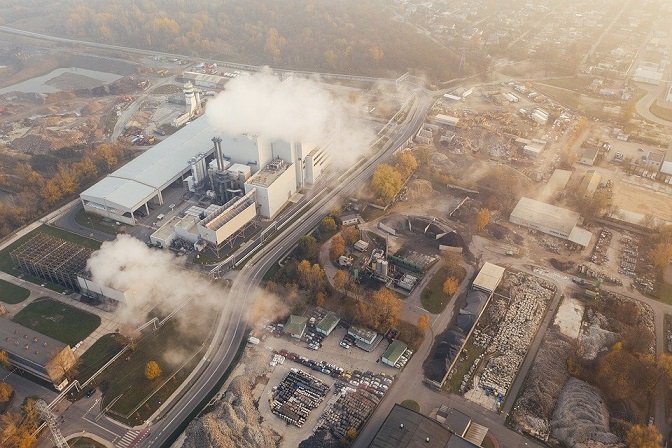The activities of human beings primarily cause greenhouse gas emissions. While carbon dioxide is naturally present in the atmosphere, it is increased by burning fossil fuels. Many industries burn fossil fuels in the production, transportation, and distribution processes which eventually leads to higher levels of greenhouse gases in the atmosphere.
There are a lot of opinions on how to solve the problem of rising global temperatures and the significant impact that humans have. However, one of the most significant problems is the lack of technology to help us solve this problem. That's where the internet of things can help.

The Internet of Things (IoT)
IoT is a system of interconnected devices and resources that transmit data over a network without human-to-human or human-to-computer interaction. IoT isn't just a single device. It's made up of several different types of devices that communicate with each other and do everything from controlling our homes to monitoring our health.
How Can Companies Reduce Their Carbon Footprint?
Companies are trying to reduce their carbon footprint and leaning towards using intelligent technologies like IoT-connected sensors, actuators, RFID tags, and machine learning devices to monitor and manage activities inside factories. These intelligent devices can monitor the status of machines such as pumps, compressors, and engines inside factories to reduce carbon emission levels.
Certain IoT use cases can help the world become greener in specific ways. Here are a few ways to reduce carbon emissions globally:
Monitoring & managing emissions
IoT can help reduce your carbon footprint by enabling several applications related to energy management, efficient use of resources, including water management, and more efficient waste management. IoT has the potential to transition energy grids to be powered by renewable sources like wind and solar power through intelligent metering and forecasting.
IoT and electric vehicles
IoT has already made it easier to build more eco-friendly cars that don't rely on gas for combustion. Still, it can also make it easier for manufacturing plants to collect data on how they could optimize their power usage (or even use alternative forms of energy like solar power).

Deploying solar power
Using solar panels is one of the best ways a company can tap into renewable energy sources and reduce its carbon footprint. With the IoT, companies can now make use of solar panels that are cost-effective and efficient in generating power.
Use smart sensors that are energy efficient
Smart sensors today can reduce as much as 17% of electricity consumed. Deploying these smart sensors in offices, factories, and other business facilities will help you improve energy efficiency by a significant margin.
Monitor your company's carbon footprint with the use of IoT
You can easily monitor and analyze data from the various devices connected to your IoT network. You can have real-time insights into how much energy your company is consuming.

Why We Need to Reduce Carbon Footprint
According to the Paris Agreement, all countries must take action to reduce their greenhouse gas emissions by at least 40 to 70 % lower than the emission levels back in 2010 by the year 2050. This is a lofty goal that would require countries and corporations to initiate their initiatives and programs. Luckily, the Internet of Things (IoT) can help industries execute their initiatives toward reducing carbon emissions and greenhouse gas emissions.
In a report published by Ericsson, the use of IoT can reduce emissions by as much as 63.5 gigatons by the year 2030, should all industrial sectors participate. Companies are trying to reduce their carbon footprint using IoT. IoT will be an enabler that will help industries reduce their greenhouse gas emissions and increase their energy efficiency.
The role of IoT in energy efficiency
IoT-enabled devices have been used in the energy industry for quite some time now. One of the first use cases of IoT was when energy providers started installing energy meters connected to their central systems via wireless communications. This enabled real-time monitoring of energy consumption on a per meter basis.
One example is the Digital Power Plant by GE, which was reported to achieve up to 62.2% energy efficiency rating in their combined-cycle power plants. Other technology giants like Cisco and Fujitsu are also developing various IoT-enabled tools and gadgets geared towards driving energy efficiency. These innovations were first used in the energy industry, but others can also harness such technologies.

The role of IoT in lighting efficiency
Intelligent lighting solutions will be able to cut back on energy consumption in buildings and facilities by 40% or more when deployed. You can take efficiency way further with IoT-enabled smart lighting sensors that will make lighting more innovative and more responsive, automatically turning on and turning off lighting fixtures depending on the presence or absence of people.
The role of IoT efficient heating and cooling systems
The use of IoT devices like smart thermostats, smart plugs, and other smart devices can significantly reduce the consumption of energy and reduce carbon emissions. As new technologies are developed, continuous monitoring and control will be possible for any industry engaged in heating and cooling services.
The role of IoT in warehouse
The IoT, like Electronic Labels, is used in warehouse management and helps in reducing carbon footprinting. MinewTag offers ESL that uses the latest technology and helps companies start warehouse and store management with IoT.
IoT has touched millions of lives, and it can help us improve the environment too. It's a clean energy initiative that can be successful only with the help of Internet access to businesses and industries. IoT is making the world a better place by low carbon footprint and helping to sustain natural resources. It improves industries that have harmful emissions by reducing them dramatically.











